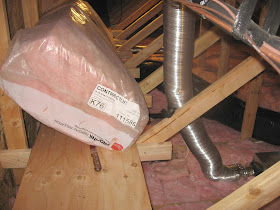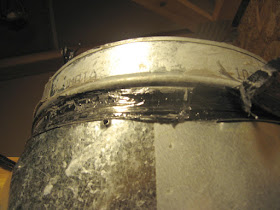Proposal submitted 1/4/2016:
R402.2.4 Access hatches and doors. Hinged doors and lift portals from conditioned spaces to unconditioned spaces (e.g. attics, unconditioned basements and crawl spaces) shall be insulated to the Energy Star standards of exterior opaque swinging doors, and shall be air sealed with well-fitting gaskets. The portal frame shall be sealed air tight in its rough opening. (The standard says: U-Factor ≤ 0.17)
The entry to an attic space at a portal shall have a surround of an ample raised floor that does not diminish insulation value. Flooring shall protect insulation against trampling while giving safe passage, to all attic electrical service points including fans, lights and junction boxes. Junction boxes not accessible from heated space shall be raised above insulation and flooring levels, or where this has failed, shall be flagged as a decked service point. Accessible service points shall include static vents that require periodic cleaning. Where a service point is buried in insulation, insulation over the service point shall be in batt form and tolerant of displacement for accessing the service point.
Existing code of 2015 says:
R402.2.4 Access hatches and doors. Access doors from conditioned spaces to unconditioned spaces such as attics and crawl spaces shall be weatherstripped and insulated to a level equivalent to the insulation on the surrounding surfaces. Access shall be provided to all equipment that prevents damaging or compressing the insulation. A wood- framed or equivalent baffle or retainer is required to be provided when loose-fill insulation is installed, the purpose of which is to prevent the loose-fill insulation from spilling into the living space when the attic access is opened, and to provide a permanent means of maintaining the installed R-value of the loose-fill insulation.
All of this, and supporting statements offered to conference readers, is summarized in page Better Building Codes For Access Portals, at my web site r5portals.
I defended my proposal at 2016 Committee Action Hearings of the International Code Council in Louisville, KY, on April 18, 2016. There was expressed disdain in the matter of insulation value of a practical hatch, that I cited rival Energy Star standards, and no acknowledgement of my comprehensive math proof, that modest insulation is best; more on that elsewhere. Here, address the second-paragraph flooring requirement, forcefully opposed by one of the rotating intervenors of the National Association of Home Builders. I took this opposition as formidable, in judges unanimously disapproving my proposal. Several participants privately encouraged me to persist in this and some of my other proposals, but no one came forward as an ally, to help if I would double my onerous personal investment, to offer and defend revised proposals, in Public Comment Hearings, Kansas City. Those "final" hearings were concluded a week ago, and I was not there. To not feel defeated, I must believe that I am intent upon readiness to try again in the next of the three-year code cycles; then having time to enlist allies.
Here, add defense of the second paragraph of my proposal. I have a really-good example to share, of work done in Oregon City, Oregon June to July, 2016. A customer had discovered that large areas of the attics in his two-year-old home had no insulation. Hard to believe, but evidence showed in zonal early frost melt on the roof, unlike neighboring homes. 500 sq ft was bare, some seen in this view. I suggest that a mandatory walkway here and an access cut further on, would have led to different and better construction choices. Impaired access is not good, for anyone.
In this photo see beginning of rapid and easy change. The scattered temporary plywood is important to my safety. I have cut down a horrible 16" OSB skirt about the small access hole.
In this photo see beginning of rapid and easy change. The scattered temporary plywood is important to my safety. I have cut down a horrible 16" OSB skirt about the small access hole.
Move interfering HVAC ducts, and temporarily detach a bath fan duct. Separate HVAC flex ducts at a wye, and move them under the diagonal truss members.
Many trips are needed along a new smooth and level walkway, upon 32" bridges of truss elements. Cut batts to fit, in the garage, and carry pieces in a growing collection of empty insulation bags. A safe passageway should not be an afterthought. Many good things, not least worker safety, result from good access. Let access be lighted too. At least, let workers find power outlets to not rely on a flashlight.
In this access exercise, learn some lessons about HVAC duct installation, attic ventilation and a further thoughtless neglect of access. Preserving duct length is very important as ducts are disassembled and reset. Yet, I must sacrifice about 6" from each flex duct at this wye, because of remnant bad advice of PTCS trainers in the service area of Bonneville Power Administration. Goop, no longer required, should never be applied for liner attachment.
Goop applied blindly and in risk of clothing, missed this under-side zone of the main branch of the wye. There was duct leakage, out of sight. UL181 Nashua 557 tape easily achieves zero leakage here, and is the right choice for easiest damage-free separation of ducts for maintenance or replacement. Know that flexible ducts have claimed useful service life of not more than ten years . See example of Thermaflex ducts as fallen-apart rat paths after about 25 years .
I know that regardless of found condition, I must replace cardboard soffit vent baffles. They rarely survive more than thirty years and when used are with no manufacturer thought or guarantee of acceptable service life (sixty years!). Here I have more than conscience in play. Curl with detached flimsy staples is ugly. Looking down at vent bird block, see poor bird block design employed by most builders. Slot placement demands vent baffles 3 1/2" down from roof sheathing, a large sacrifice of potential insulation depth over exterior wall headers. This bird block is needed in every available roof joist bay, not in every fourth.
Lumber for proper soffit vent baffles is free, in good employment of job scrap. Use 25 cents of good deck screws, not nails. I assembled six baffles in thirty minutes. This is quicker than setting a $1 cardboard baffle, thus less expensive. Wood sleds are easily adapted for obstructions, then set much more securely.
Baffles just 32" tall are ample over R45 batts. I can push R30 top-layer batts tightly against a baffle, for fullest insulation value, and that is the controlling economy.
A hidden attic around this corner was uninsulated too. The triangular access is new. Opportunity was concealed behind redundant OSB sheathing.
While I am at this I will insulate over the garage too, to just R15. I can't bear to crawl there carrying insulation, through this jungle of beam and variable trusses.
Cut in a new access for the garage, "factory built" in my shop. Where truss bottom elements are 2x4, they must not carry loads unless strengthened as composite beams. Leave a couple of 9" rips of plywood that I needed for my safety, but not more flooring.
Here is the fully-dimensioned plan of my hatch, offered to anyone as noted here.
At June 18, 2021, I revisit this post upon reading the post of this date at Insulation Institute Blog: A Hot New Home and Missing Insulation. I see that this post should go further upon process of inspection, not just means of inspection. Process should be for information to the builder and ultimate home owner and not just a manager of building permits. Building permits delve in the short-term self-interest of a builder, to get a certificate of occupancy. They involve inspection requirements often flouted. by disinterested and unmotivated municipal employees, who take an easy path where inspection is difficult or impossible.
Get better results where inspection is primarily in service of the self interest of the home occupants ever-after. Those citizens of the community are the real employers of the inspectors. Let these employers then receive indelible proof of critical performance items in the form of pdf documents I call Diligence Reports. A diligence report is created by a professional technical writer rated for integrity and skill in taking photos and notes from the builder daily to generate each required Diligence Report. Report contents are driven by task checklists, and comply with simple national standards. The involvement of three parties in the satisfaction of checklists ensures honesty.
I wondered when I would first find cause to share the humor.













Thanks for creating such an important blog related to attic access doors.
ReplyDelete